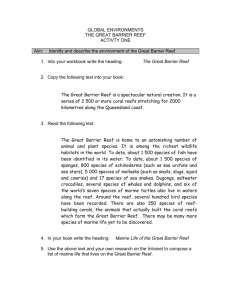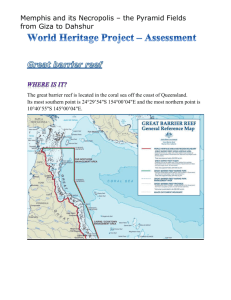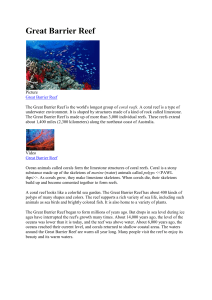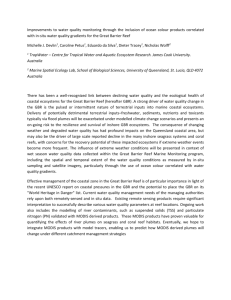Integrated unit — Great Barrier Reef — Example unit plan
advertisement
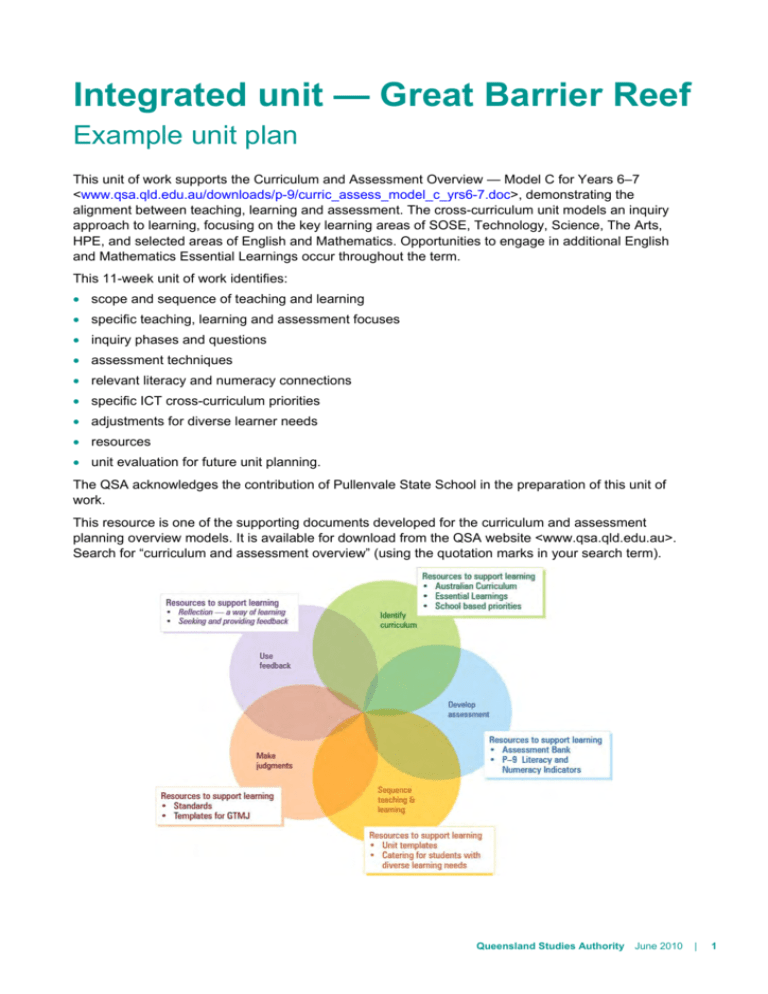
Integrated unit — Great Barrier Reef Example unit plan This unit of work supports the Curriculum and Assessment Overview — Model C for Years 6–7 <www.qsa.qld.edu.au/downloads/p-9/curric_assess_model_c_yrs6-7.doc>, demonstrating the alignment between teaching, learning and assessment. The cross-curriculum unit models an inquiry approach to learning, focusing on the key learning areas of SOSE, Technology, Science, The Arts, HPE, and selected areas of English and Mathematics. Opportunities to engage in additional English and Mathematics Essential Learnings occur throughout the term. This 11-week unit of work identifies: scope and sequence of teaching and learning specific teaching, learning and assessment focuses inquiry phases and questions assessment techniques relevant literacy and numeracy connections specific ICT cross-curriculum priorities adjustments for diverse learner needs resources unit evaluation for future unit planning. The QSA acknowledges the contribution of Pullenvale State School in the preparation of this unit of work. This resource is one of the supporting documents developed for the curriculum and assessment planning overview models. It is available for download from the QSA website <www.qsa.qld.edu.au>. Search for “curriculum and assessment overview” (using the quotation marks in your search term). Queensland Studies Authority June 2010 | 1 The Great Barrier Reef Term Year level English HPE Prep Languages 1 Mathematics 2 SOSE 3 1 2 3 4 4 5 6 7 Science The Arts Technology Context Students apply their knowledge and understanding of coral reef environments. They identify and analyse the threats to reef conservation and propose actions that minimise harm to the Great Barrier Reef. These proposals are used to create an information brochure, research folio, fair-test investigation, and a persuasive multimedia interview for the position of Reef Custodian for “The World’s Best Job”. Assessment Brochure design and creation using publishing software (Technology) Brochure script production (English — Writing and designing) Research journal: human impacts on reef environments (SOSE) Fair-test scientific investigation: water temperatures/salinity (Science) Persuasive multimedia interview (The Arts — Media; English) Reflection log and journal (HPE) Summative quizzes (across KLAs) Resources CRC Reef Research Centre < www.reef.crc.org.au>. Kingsford, M, Hutchings, P & Hoegh-Guldberg, O 2008, The Great Barrier Reef Biology, Environment and Management, CSIRO. Norman, M 2003, The Great Barrier Reef Book: Solar powered, Black Dog Books. Reef Education Network <www.reef.edu.au>. ReefED, Great Barrier Reef Marine Park Authority. Includes information on Reef HQ and the Reef Guardians program for schools <www.reefed.edu.au>. Six Thinking Hats: An Essential Approach to Business Management, de Bono, Edward 1985, Little, Brown, & Company. The Inconvenient Truth (DVD), 2007, Davis Guggenheim, Paramount Pictures. The Great Barrier Reef <www.greatbarrierreef.org>. The Great Barrier Reef (DVD), National Geographic, <http://video.nationalgeographic.com/video/player/places/parks-and-nature-places/oceans/oceans-barrierreef.html>. Thinkers Keys (CD-ROM), Ryan Publishing, Melbourne, Victoria. Winton,T 2008, Blueback, Pengin Australia. Values focus Others Informed child Students understand the significance of their actions and the influence they have on the world around them. 2 | The Great Barrier Reef Democratic child Students are able to work in groups and respect other views and opinions. Environment Eco-child Students are aware of the human impact on environments. Scope and sequence of learning Inquiry phase — Ideas Week 1 Tuning in (Orientation) Pre-learning graphic organisers Finding out (Enhancing) Reading, interviewing, experimenting, researching Week 2 Sorting out Organising information in a meaningful way Values link: Informed child Teaching and learning experience KLA connections Introduction to topic and getting started Introduce students to unit. Create a KWHL chart on what we know about the Great Barrier Reef, and what we want to know. View videos — The Great Barrier Reef and The Inconvenient Truth. Complete two pre-learning graphic organisers (e.g. Squiggle, If you know it show it, Thinkers keys). Have students select role to focus their investigation (e.g. farmer, eco-tourist, fisher/angler, resort manager, park ranger). Have students design cover of journal. First response using De Bono’s Six Thinking Hats. SOSE Introduction to the Great Barrier Reef (cont.) Use Thinkers Keys to create ideas and encourage learning/ thinking about different information (e.g. brainstorming key: list as many different ideas as possible about the Great Barrier Reef; alphabet key: make an A–Z list of words about the Great Barrier Reef). Introduce and explain assessment and learning for unit. Clarify student groups and working tasks/involvement. Start research about the Great Barrier Reef (SOSE, Science). Start brochure planning (English; Technology; The Arts — Media). Identify “Reef Custodian” job content — persuasive pitch (English). Introduce fair-test — water temperatures/salinity (Science). SOSE Science English Technology The Arts — Media Assessment Resources Personal journal response to a set of prompted questions (Formative) Personal response to a pre-learning organiser (Formative) Research journal compilation for brochure (Formative) Running anecdotal records (Formative) Thinkers keys in folio (Formative) KWHL chart Graphic organisers Videos: The Great Barrier Reef and The Inconvenient Truth Projector/TV Task sheet Worksheet Information sheets coral reef Great Barrier Reef atolls Videos: The Great Barrier Reef and The Inconvenient Truth Queensland Studies Authority June 2010 | 3 Scope and sequence of learning Week 4–5 Week 3 Inquiry phase — Ideas 4 | Going further (Synthesising) Where to from here? What am I going to do with the information I have learned? Putting ideas into practice. Integrated unit title Teaching and learning experience KLA connections Tour and guided note-taking Introduce guided note-taking (e.g. looking at what is a coral reef). Group/paired work: practise note-taking on The Great Barrier Reef. Tour an aquarium or marine theme park. View segments from The Inconvenient Truth video. Practise note-taking and discuss. English SOSE (using primary and secondary sources) Research and investigation: life within the Great Barrier Reef Share group information about living organisms. Conduct science fair-test investigation, e.g. salinity/temperature/pollutants. Prepare and produce a group report and share findings with class. Record shared information on concept map. Science SOSE Refining Facilitate discussion. Design presentation of brochure; what have we achieved/what still needs to be achieved to successfully complete the task of finalising the brochure. Identify and discuss topics and key text features that should be included in presentation and brochure. Create criteria sheet for group task. Negotiate, plan and identify decision-making processes for group responsibility in research investigation and video interview. Second response using De Bono’s Six Thinking Hats. Technology (design process) English SOSE (research) HPE (group roles, responsibilities and strategies, self and peer feedback) The Great Barrier Reef Assessment Note-taking (Formative) Knowledge quiz (Summative) Resources Field trip log Note-taking sheets Information sheets on a range of reef animals Examples of research journals, reflection logs, etc. Research folio annotations (Formative) Fair-test experiment and report (Formative and Summative) List of recommended websites Draft of brochure layout and text structure (Formative) Draft text for brochure (Formative) Research journal (Formative) Peer and self feedback and reflection sheet (Formative) Task sheet Blank peer criteria sheet Research materials and resources: websites and books Reflection journal Scope and sequence of learning Week 9–10 Week 8 Week 7 Inquiry phase — Ideas Going further (Synthesising) How do I design an effective information brochure? Teaching and learning experience KLA connections Assessment Transform notes into a report Students continue to collect, organise and refer to a variety of primary information sources about the Great Barrier Reef. Discuss presentation of draft brochure. Transform notes into sentences. Identify appropriate sections of the report. Refine first draft. SOSE English Discuss brochure layout Examine a number of brochures and discuss layout, colour, font, illustrations and overall presentation. Produce storyboard and make layout plans using design process. Discuss and record criteria for an effective brochure. Design and create first drafts of the individual brochures using publishing software. Compose and make video interview View and deconstruct a video interview. Discuss features of a video interview (e.g. camera angle and shots). Establish purpose and structure of video. Review presentation skills for interview. Create video using digital video camera and editing software. Technology (design process and creation of storyboards) The Arts — Media (creation of persuasive video interview) English Create brochure and practise presentation Rotation 1: Refine and edit final draft of brochure. Rotation 2: Computer access for brochures. Rotation 3: Practise presentation. Resources Initial draft and creation of brochure and persuasive video (Summative) Synthesis of information notes to information texts (Formative) Example brochures Computer access Research materials and resources Knowledge quiz (Summative) Design and evidence of refinements in design log for brochure (Formative) Text structure of brochure(Formative and summative) Word processing and publishing software Digital video camera and video editing software Brochure production HPE self and others journal entry Presentation script (Summative) Research folio (Summative) Queensland Studies Authority June 2010 | 5 Scope and sequence of learning Inquiry phase — Ideas Drawing conclusions Reflection cards (cards with starters like “I am most proud of…”, “Today I learned…”, “I would like to know more about…”) Week 11–12 Values links: Eco-child and informed child 6 | Integrated unit title Teaching and learning experience Presentations and reflection View video/perform reef job presentation interviews for peers or other identified audiences. Evaluate and discuss investigation topic and new learning and understandings (what worked well, challenges, new learning, improvement). Respond to reflection questions and identify new understandings. Revisit Week 1 graphic organiser and complete it using new knowledge gained through this unit. Review the video The Inconvenient Truth. Final response using De Bono’s Six Thinking Hats. Complete self-assessment and reflection activity using the following questions: What is the most important thing I have learnt about the Great Barrier Reef and other coastal areas? What are the key issues with global warming and its impact on the world’s biomes? What is the one thing I have learnt about myself and how I might treat coastal environments? What can I do at home to protect places like the Great Barrier Reef? Why have governments and businesses not planned and put in place protection laws earlier? What would I still like to find out about the Great Barrier Reef and other marine areas of its kind? What piece of work am I most satisfied with? Why? The Great Barrier Reef KLA connections SOSE English Technology The Arts — Media HPE Assessment Reef job presentation (Summative) Public readings or displays of brochure work (Summative) Journal responses (Summative) Self reflection (Summative) Graphic organiser to prompt reflective responses (Summative) Resources The Inconvenient Truth (DVD) Display areas around school Targeted Essential Learnings English (Essential Learnings in italics are the particular focus of assessment.) Essential Learnings (ELs) Specific learning focuses (ELs in the context) Assessment Ways of working Students are able to: identify and demonstrate the relationship between audience, subject matter, purpose and text type identify main ideas and the sequence of events, make inferences and draw conclusions based on ideas and information within and across texts construct non-literary texts to express meanings and messages, to identify causes and effects, and to state positions supported by evidence reflect on learning, apply new understandings and identify future applications. Identify research information, make inferences and draw conclusions for multimodal texts (brochure and video). Draft research and information notes in journal Storyboard for video clip Knowledge and understanding Speaking and listening In presentations, speakers make meaning clear by organising subject matter, identifying their role and selecting relevant resources. Organise notes to create a structured and informative video interview. Video clip: produce, storyboard and capture on video an informational interview Reading and viewing Readers and viewers use a number of active comprehension strategies to interpret texts, including activating prior knowledge, predicting, questioning, identifying main ideas, inferring, monitoring, summarising and reflecting. Research issues relating to the Great Barrier Reef — note-taking, summarising, organising notes/info. Brochure: construct an information brochure using publishing sofware Writing and designing The purpose of writing and designing includes evoking emotion, persuading and informing. Design speech to demonstrate knowledge of the reef and persuade an audience why they are suitable for the Reef Custodian job. Identify and set up scenarios for a Great Barrier Reef role that will persuasively present a particular viewpoint or position (e.g. tour operator, farmer, fisher, park ranger). Video clip: design product/text type based on audience, purpose, scenario and position Language elements Paragraphs sequence information and arguments, and include topic sentences that emphasise a point or argument. Evaluative language, including adjectives, can appeal to certain groups, express opinions, and represent people, characters, places, events and things in different ways. Write text using paragraphs and sub-headings to persuade and inform a Year 6 audience. Produce assorted non-literary texts to meet audience and purpose (e.g. visual media, auditory content). Use of text structures across texts Evidence of persuasive language to position and inform audience in brochure and video dialogue Queensland Studies Authority June 2010 | 7 Targeted Essential Learnings Literary and non-literary texts Main ideas, issues and events are selected and organised to sustain a point of view and to project a level of authority that matches a purpose and an intended audience. Non-literary texts evaluate, inform, present arguments and persuade. Examine and analyse persuasive language elements and strategies; incorporate these into information text in order to add authority to topic and message. Design and construct brochure Assessable elements Students demonstrate evidence of their learning over time in relation to the following assessable elements: Knowledge and understanding Interpreting texts Constructing texts Appreciating texts Reflecting SOSE (Essential Learnings in italics are the particular focus of assessment.) Essential Learnings (ELs) Specific learning focuses (ELs in the context) Assessment Ways of working Students are able to: collect and analyse information and evidence from primary and secondary sources communicate descriptions, decisions and conclusions, using different text types for specific purposes and the conventions of research-based texts reflect on learning, apply new understandings and identify future applications. Conduct research using a range of authoritative sources (e.g. internet, books, videos) and analyse information obtained (e.g. note-taking, retrieval charts). Communicate new understandings and knowledge gained through research findings in brochure and video production. Identify target audience — general public, classmates or other. Reinforce the purpose of texts — raising awareness of conservation issues and a “video clip” dream job oral presentation. Research notes and synthesis of information gained from primary sources Video clip: research Identify, investigate and respond to the human impacts on the Great Barrier Reef including: tourism — fishing, sightseeing, holidaying environmental issues (global warming) — pollution, water temperatures, salinity. Discuss what it takes to achieve a balance: monitoring and restricting human activity conditional use/access to Great Barrier Reef. Brochure: information synthesis Quiz Knowledge and understanding Place and space Australian environments are defined by patterns of natural processes, by human activities and by the relationships between them, including climate and natural resource distribution, resource use, and settlement patterns. Sustainability requires a balance between using, conserving and protecting environments, and involves decisions about how resources are used and managed. Assessable elements Students demonstrate evidence of their learning over time in relation to the following assessable elements: Knowledge and understanding 8 | Integrated unit title The Great Barrier Reef Investigating Communicating Participating Reflecting Targeted Essential Learnings Science (Essential Learnings in italics are the particular focus of assessment.) Essential Learnings (ELs) Specific learning focuses (ELs in the context) Assessment Ways of working Students are able to: evaluate information and evidence and identify and analyse errors in data select and use tools scientific tools and technologies suited to the investigation draw conclusions that summarises and explain patterns in data and are supported by experimental evidence and scientific concepts communicate scientific ideas, data and evidence, using scientific terminology suited to the context and purpose reflect on different points of view and recognise and clarify people’s values relating to applications and impacts of science. Research and evaluate the Great Barrier Reef zone restrictions and look at what having these zones achieves. Examine information and draw conclusions using valid scientific information drawn from primary or authoritative and scientifically valid sources to support conclusions. Identify fair-test components — hypothesis, purpose, materials, observations, data table, discussion, conclusion (variables — change something, measure something, something stays the same — control). Examine and model all fair-test components to be included: purpose, hypothesis, materials, control (including variables), measure, observations, data, discussion and conclusion. Explore and discuss differing reasons and choices made by humans to use and access the resources of the Great Barrier Reef. Identify the consequences of these choices. Examine and respond to primary documents from government and non-government authorities, and United Nations to protect natural resources and landforms. Graphic organiser/retrieval chart Knowledge quiz using data and life cycle visuals Knowledge and understanding Science as a human endeavour Science relates to students’ own experiences and activities in the community. Investigate how tropical marine life relies heavily on water temperature and sunlight to survive and where human impacts create unbalance in this ecosystem. Fair-test report Life and living Survival of organisms is dependent on their adaptation to their environment. Use inquiry-based experiments and research to investigate and learn about coral reef biome, life cycles and conditions. Investigation report Assessable elements Students demonstrate evidence of their learning over time in relation to the following assessable elements: Knowledge and understanding Investigating Communicating Reflecting Queensland Studies Authority June 2010 | 9 Targeted Essential Learnings Technology (Essential Learnings in italics are the particular focus of assessment.) Essential Learnings (ELs) Specific learning focuses (ELs in the context) Assessment Ways of working Students are able to: generate and evaluate design ideas and determine suitability based on purpose, specifications and constraints plan and manage production procedures and modify as necessary. Design, prepare and refine design decisions for brochure to suit intended purpose. Create rough storyboard plan of brochure with six-page layout. Refine, produce and evaluate ongoing effectiveness of brochure design decisions. Design, plan, and create an brochure using publishing software Draft annotated storyboards Knowledge and understanding Technology as a human endeavour: Technology influences and impacts on people, their communities and environments. Decisions made about the design, development and use of products can impact positively or negatively on people, their communities and environments. Provide and receive partner feedback and reflection on draft production. Peer and self-reflection and feedback Information, materials and systems Techniques and tools are selected to manipulate or process resources to enhance the quality of products and to match design ideas, standards and specifications. Insert texts, graphics and other visuals to match product with purpose and audience. Draft and final production of brochure Assessable elements Students demonstrate evidence of their learning over time in relation to the following assessable elements: Knowledge and understanding 10 | Integrated unit title The Great Barrier Reef Investigating and designing Producing Evaluating Reflecting Targeted Essential Learnings The Arts (Essential Learnings in italics are the particular focus of assessment.) Essential Learnings (ELs) Specific learning focuses (ELs in the context) Assessment Ways of working Students are able to: create and shape arts works by modifying arts elements to express purpose and to include influences from their own and other cultures and times present arts works to informal and formal audiences for intended purposes, using arts techniques, skills and processes. Plan and design layout and form of digital brochure and promotional video. Create visual stories to represent what position you have assumed for the Great Barrier Reef. Planning and refinement of storyboards representing ideas and decisions Plan, design and create video clip Compose and plan sequenced storyboards of promotional video. Produce, shoot and edit video clips using video editing software. Public display of production to identified audiences. Reflection Photo story (summative) Knowledge and understanding Media Media techniques and practices, including editing and publishing, are used to create media texts. Still and moving images, sounds and words are applied and modified, using genre conventions, to construct media texts. Assessable elements Students demonstrate evidence of their learning over time in relation to the following assessable elements: Knowledge and understanding Creating Presenting Responding Reflecting Queensland Studies Authority June 2010 | 11 Targeted Essential Learnings Mathematics (Essential Learnings in italics are the particular focus of assessment.) Essential Learnings (ELs) Assessment Ways of working Students are able to: analyse situations to identify mathematical concepts and the relationships between key features and conditions necessary to generate solutions plan activities and investigations to explore concepts through selected pathways, and plan strategies to solve mathematical questions, problems and issues communicate thinking and justify reasoning and generalisations, using mathematical language, representations and technologies reflect on and identify the contribution of mathematics to their life. Maths investigations Maps, longitude of the Great Barrier Reef Number operations Formative quizzes and summative tests — end-point concept consolidation Knowledge and understanding Number Common fractions can be represented as equivalent fractions, decimals and percentages for different purposes. Percentages, rate, ratio and proportion can be used to describe relationships between quantities and to solve problems in practical situations involving money, time and other measures. Measurement Timetables and duration of events involving both 12- and 24-hour time cycles and Australian time zones can be calculated. Appropriate instruments, technologies and scale are used when exploring measurement of length, area, volume, mass, time and angles where not all of the graduations are numbered. Chance and data Sample data drawn from a given population can be summarised, compared and represented in a variety of ways. Measures of location such as mean, median and mode, and frequency and relative frequency, can be used to explore distributions of sample data. Space Maps and plans can be constructed and interpreted to identify a specific location, to plan movement from one location to another, and to calculate distance between locations. Mapping conventions, including coordinates, compass points and scale, are used to specify and identify locations on maps and plans. Assessable elements Students demonstrate evidence of their learning over time in relation to the following assessable elements: Knowledge and understanding 12 | Integrated unit title The Great Barrier Reef Thinking and reasoning Communicating Reflecting Targeted Essential Learnings HPE (Essential Learnings in italics are the particular focus of assessment) Essential Learnings (ELs) Specific learning focuses (ELs in the context) Assessment Ways of working Students are able to: collect, analyse and evaluate information and evidence propose, justify, implement and monitor plans or actions to promote health and well being movement capacities and personal development create and perform movement sequences through modifying and combining skills and applying movement concepts select and demonstrate appropriate personal development skills and strategies in team and group situations reflect on and identify the impact of diverse influences on health and well being, movement capacities and personal development, including the best use of positive influences. Journal and reflection responses Peer and self reflection log for video production Knowledge and understanding Health Family, peers and the media influence health behaviours. Establish roles and responsibilities for group production. Create messages that promote healthy lifestyles and benefits of outdoors and healthy environments. Personal development Identity and self-image are influenced by environmental factors, including the media, and social expectations of age, gender and culture. Assuming roles and responsibilities, experiencing leadership opportunities, respecting cultural protocols and differences and working well with others, develops positive identity and selfesteem. Life events and transitions can be dealt with through meaningmaking, resilience strategies, and use of personal and community resources. Work collaboratively, negotiate and record feelings, actions and responses to strategies used to resolve conflict, meet deadlines and produce product as part of a team and as an individual. Assessable elements Students demonstrate evidence of their learning over time in relation to the following assessable elements: Knowledge and understanding Investigating Planning Implementing and applying Reflecting Queensland Studies Authority June 2010 | 13 Targeted Essential Learnings Year 7 juncture — ICT Cross-curriculum priorities for this unit Teaching and learning Inquiring with ICTs Students explore and use ICTs in the processes of inquiry and research across key learning areas. They: plan, conduct and manage structured and advanced searches for data and information in response to questions. Creating with ICTs Students experiment with, select and use ICTs to create a range of responses to suit the purpose and audience. They use ICTs to develop understanding, demonstrate creativity, thinking, learning, collaboration and communication across key learning areas. They: express and creativity represent ideas, information and thinking. Communicating with ICTs Students experiment with, select and use ICTs across key learning areas to collaborate and enhance communication with individuals, groups or wider audiences in local and global contexts for an identified purpose and audience. They: consider how ICTs can be used to enhance interpersonal relationships and empathise with people in different social and cultural contexts select and apply a variety of digital media to improve communication. Ethics, issues and ICTs Students understand the role of some ICTs in society. They develop and apply ethical, safe and responsible practices when working with ICTs in online and stand-alone environments. They: apply codes of practice for safe, secure and responsible use of ICTs apply protocols to acknowledge the owner(s)/creators(s) of digital information sources and develop an awareness of legislation relating to digital theft and plagiarism. Operating ICTs Students use a range of advanced ICT functions and applications across key learning areas to inquire, create, collaborate and communicate, and to manage information and data. They: 14 | access appropriate network, personal system and device information develop strategies for learning new ICT operations and consider different ways to perform tasks develop operational skills and begin to use the extended functionality of a range of ICT devices. Integrated unit title The Great Barrier Reef Assessing Adjustments to meet the needs of all learners Consider adjustments from the Knowledge, Interaction, Situation and Success model to engage students with varying levels of ability or need. Knowledge adjustments Teacher–parent/carer communication (IEP/reports) or homework support Individual learning goal Modified texts Visual and pictorial supports — word lists, self management chart, pictorial timetable Interaction adjustments “Wait time” for student to process information Repeated presentation of key points Short, clear instructions Small group or one-to-one instruction and modelling Task recall and clarification with student Home–school communication book for recall of experiences across environments Adjustments of learning pedagogy Review of target skills with teacher aide Graphic organisers Slower pace for instruction Concrete materials Direct instruction-modelling, prompting, practice and feedback Picture sequencing for story writing Multimedia to teach specific concepts Skills practice with teacher-aide Check for awareness of phonemes, sentence structure, word meaning or social function of language Use of student’s prior knowledge Planned teaching sequence to scaffold written and oral comprehension Frequent checks to ensure that instructions are understood Buddy support for information interactions Consistent behavioural strategies across all contexts Involvement of AVT, GO, OT, SLP in classroom planning Encourage editing of work, extracting the main idea, punctuation, grammar, word lists, spelling strategies Picture prompts to help organisation Situation adjustments Success adjustments Targeted activities that fit with regular class activities Writing tasks completed on computer to support development of fine motor/hand writing skills Quiet area for difficult work Modified report card Monitoring of social situations (e.g. playtime) Additional time for oral presentations Peer support Modelling and prompting of appropriate responses Consistent behavioural strategies across all contexts Colour coding of subject material Visual timetable Preferential seating — close to teacher or supportive buddy Queensland Studies Authority June 2010 | 15 Learning how to learn, literacy and numeracy Learning how to learn 16 | Assist students with appropriate use of internet search engines (ask.com) and keyword search strategies. Guide students through challenges in group work, roles and responsibilities. Set up an ICT mentor role for students who show aptitude for video, brochure creation and graphing skills. Invite community members, peers or other classes to enjoy, provide feedback and be involved in celebration of learning opportunities. Encourage the use of logs or journals to record on a regular basis new learning, challenges and thoughts. Integrated unit title Literacy Blueback by Tim Winton — examine messages across text identifying man versus animal and sense of place in the ocean. Incorporate new scientific and persuasive vocabulary facts and shape video, brochure and research folio. Ask students to respond to key question —- Is this a book for children or a book for adults? Does it really matter? Does it affect us? Consider the scientific facts and issues presented in The Inconvenient Truth and record key points in journal. Possible connections to Literacy Indicators: SL 6.i, ii, iii, iv RV 6 i, iii WD 6 i, v, ix, x The Great Barrier Reef Numeracy Graphing survey results Data collection from fair-test experiments Timeline of Great Barrier Reef history/events Latitude and longitude on maps Australian time zones Measurement — Real-life look at area of the Great Barrier Reef zone Possible connections to Numeracy Indicators: N 6 ii, x M 6 iii, S 6 ii, iii CD ii Teacher evaluation Please reflect and comment on aspects of the unit, for example, inquiry questions, sequencing, strategies, assessment modes, resources, student interest, professional development needed. Tuning in phase Finding out phase Sorting out phase Going further phase Drawing conclusion phase Resources Other comments Queensland Studies Authority June 2010 | 17


